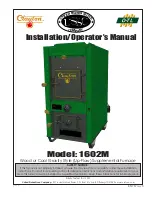
21
Fan Only
1. The thermostat calls for Fan Only by energizing “G.”
2. Immediately, the indoor blower fan Is energized at the
low-heat speed.
3. The indoor blower fan is immediately de-energized once the
thermostat call for Fan Only is removed.
Cooling Start-Up
NOTE: Check all manual reset limit controls in heating circuit if
cooling mode does not operate.
Compressor Protection Devices
The compressor includes components which are designed to
keep the compressor from abnormal operating conditions.
Refrigerant Charge Check—Units with Fixed Orifice
Devices
After completing the airflow measurements and adjustments, the
unit’s refrigerant charge must be checked. The unit comes
factory charged, but this charge is based on 325 CFM per ton
and minimum ESP per ARI test conditions (generally between
0.15 to 0.25 ESP). When air quantity or ESP is different than
above, the refrigerant charge must be adjusted to the proper
amount.
All package units with fixed orifice devices are charged using the
superheat method at the compressor suction line.
For charging in the warmer months, 8ºF ± 3ºF superheat at the
compressor is required at conditions 95ºF (35ºC) outdoor
ambient (dry bulb) temperature, 80ºF (27ºC) dry bulb / 67ºF
(19ºC) wet bulb indoor ambient temperature, approximately 50%
humidity. This superheat varies when conditions vary from the
conditions described.
After superheat is adjusted, it is recommended that subcooling
be checked at the condenser coil liquid line out. In most
operating conditions 10ºF to 15ºF of subcooling is adequate.
Cooling Refrigerant Charging—Models with TXV
Check the unit charge before putting the cooling section into full
operation. The unit is factory-charged with R-410A for nominal
airflow and static pressure conditions. The unit has a
thermostatic expansion valve (TXV) metering device. To ensure
that the unit is properly charged for the intended application,
check the unit refrigerant subcooling at the condenser. The
refrigerant subcooling is a function of outdoor ambient
temperature and return air temperature of the conditioned space.
It is the installing contractors responsibility to ensure that the
proper refrigerant subcooling at the condenser is adjusted for
each application. For example, 10ºF refrigerant subcooling level
is adequate for a 95ºF (35ºC) outdoor ambient temperature and
for a 78ºF to 80ºF (26ºC to 27ºC) indoor return air temperature.
As the outdoor ambient temperature rises, the subcooling
decreases, and as the outdoor ambient temperature lowers, the
subcooling increases.
NOTE: Proper subcooling adjustment optimizes cooling
performance.
On models equipped with a thermostatic expansion valve, charge
the system to 10º of subcooling. When necessary, adjust the
expansion valve stem for superheat setting.
NOTE: The expansion valve will not need adjustment for most
applications. Check that the system superheat is set between
12ºF and 15ºF after final adjustment.
Superheat Adjustment
1. To adjust superheat, remove the control box cover and locate
the expansion valve on the liquid line of the evaporator.
2. Unscrew the cover from the expansion valve
3. Locate the adjustment screw, and turn it clockwise (in) to
increase superheat or counterclockwise (out) to decrease
superheat.
4. Replace the adjustment cap.
5. Wait a minimum of 10 minutes between adjustments to allow
time for the TXV and pressures to stabilize.
Cooling Operation
NOTE: Mechanical cooling cannot be reliably provided at
ambient temperatures below 50°F (10ºC).
1. Turn on the electrical power supply to the unit.
2. Place the room thermostat selector switch in the COOL
position (or AUTO if available, and if automatic changeover
from cooling to heating is desired).
3. Set the room thermostat to the desired temperature.
Goodman 95
To prevent personal injury or death, always disconnect
electrical power before inspecting or servicing the unit.
All compressor protection devices reset automatically,
energizing the contactor and outdoor fan.
WARNING








































